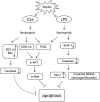Neutrophil dysregulation during sepsis: an overview and update
- PMID: 28244690
- PMCID: PMC5571534
- DOI: 10.1111/jcmm.13112
Neutrophil dysregulation during sepsis: an overview and update
Abstract
Sepsis remains a leading cause of death worldwide, despite advances in critical care, and understanding of the pathophysiology and treatment strategies. No specific therapy or drugs are available for sepsis. Neutrophils play a critical role in controlling infection under normal conditions, and it is suggested that their migration and antimicrobial activity are impaired during sepsis which contribute to the dysregulation of immune responses. Recent studies further demonstrated that interruption or reversal of the impaired migration and antimicrobial function of neutrophils improves the outcome of sepsis in animal models. In this review, we provide an overview of the associated mediators and signal pathways involved which govern the survival, migration and antimicrobial function of neutrophils in sepsis, and discuss the potential of neutrophils as a target to specifically diagnose and/or predict the outcome of sepsis.
Keywords: neutrophil antimicrobial activity; neutrophil extracellular traps; neutrophil migration; sepsis; signal pathway.
© 2017 The Authors. Journal of Cellular and Molecular Medicine published by John Wiley & Sons Ltd and Foundation for Cellular and Molecular Medicine.
Figures



References
-
- Dellinger RP, Levy MM, Rhodes A, et al Surviving sepsis campaign: international guidelines for management of severe sepsis and septic shock: 2012. Crit Care Med. 2013; 41: 580–637. - PubMed
-
- Levy MM, Artigas A, Phillips GS, et al Outcomes of the Surviving Sepsis Campaign in intensive care units in the USA and Europe: a prospective cohort study. Lancet Infect Dis. 2012; 12: 919–24. - PubMed
-
- Kaukonen KM, Bailey M, Suzuki S, et al Mortality related to severe sepsis and septic shock among critically ill patients in Australia and New Zealand, 2000–2012. JAMA. 2014; 311: 1308–16. - PubMed
Publication types
MeSH terms
Substances
LinkOut - more resources
Full Text Sources
Other Literature Sources
Medical

